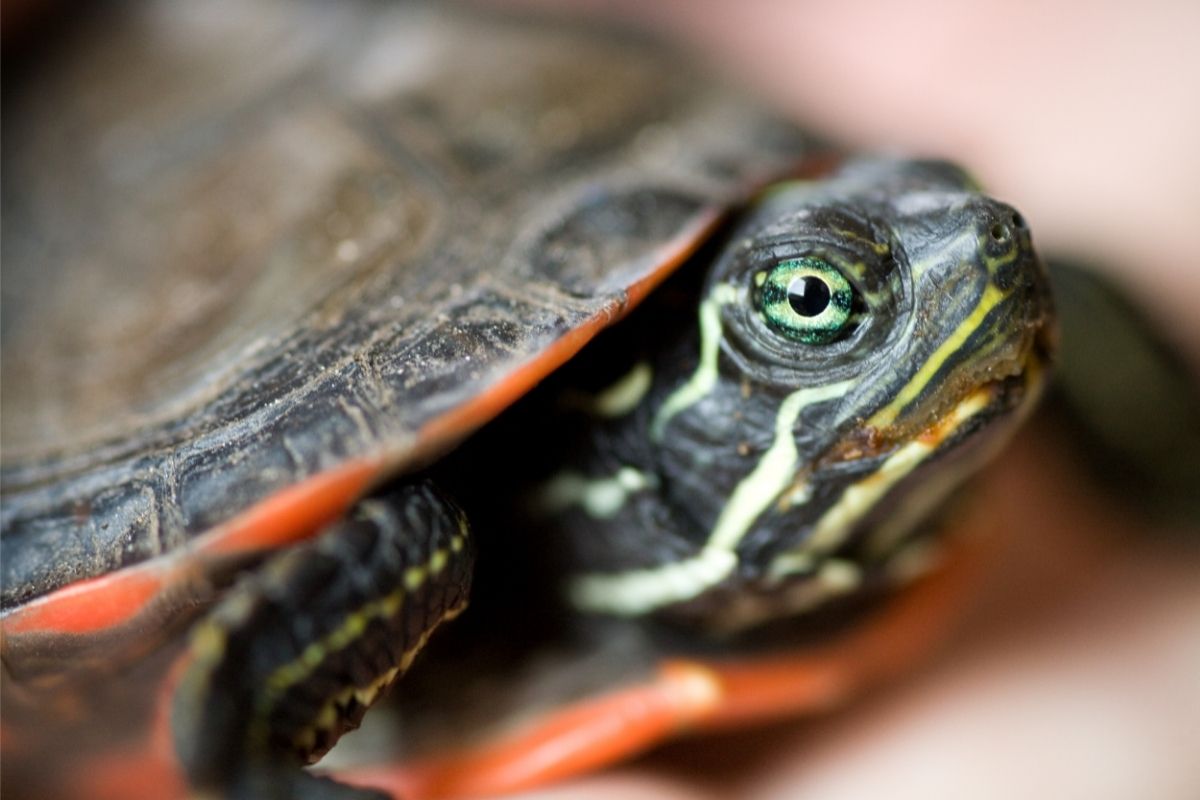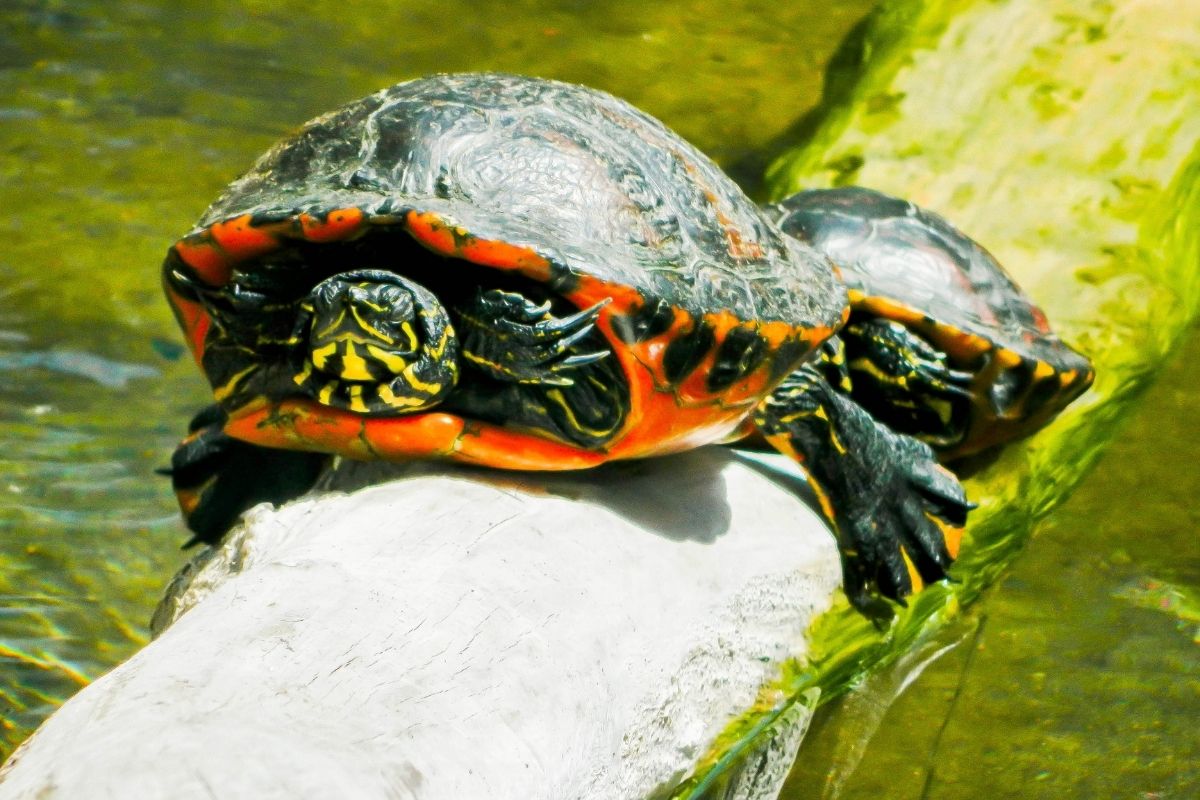Red-bellied turtles are native to Australia and New Guinea but found around America. They are omnivores, meaning they eat both plants and animals.
The red-bellied turtle has become a popular pet due to its friendly nature.

These reptiles are often kept as pets because they are relatively inexpensive and easy to care for.
If you want to take care of them properly, you should feed them a balanced diet consisting of fruits, vegetables, and meat.
In this article, we are going to uncover what red-bellied turtles are in the wild and what you can feed them as a pet.
Red-Bellied Turtles: What Are They?
You can find red-bulled turtles all over America. In particular, you can find them in freshwater habitats in coastal regions of North Carolina, Maryland, and West Virginia, and they can also be found in the Potomac River.
When young, these typically have a green-like shell with an orange hue across the flat surfaces of the shell. Once they are adults, this orange color is a lot more noticeable.
The red bands at the base of the shell are much more visible once the shell has gotten wet.
When first looking at a red-bellied turtle, you may see a close similarity to the painted turtle. Although, the best way to tell the difference between a painted and a red-bellied turtle is by the size of the turtle.
Also, the painted turtle is known to have a yellow marking on their heads, which is not seen on the head of a red-bellied turtle.
A Red-Bellied Turtle’s Diet
A red-bellied turtle is known to be an omnivore. This means that their diet can change depending on the environment that they find themselves in.
When a red-bellied turtle is kept as a pet, then they can live well off homemade and store-bought turtle food. Although, you should try to replicate as close as you can their natural diet in the wild. This will keep them as healthy as possible.
The Diet Of A Wild Red-Bellied Turtle
In the wild, a red-bellied turtle will be a mixture of plants and animal-based foods. However, an adult red-bellied turtle will typically be a harbor.
This means they will eat mainly aquatic vegetation and algae. However, they do really enjoy eating some invertebrates, such as insects, shrimp, small fish, amphibians, and crayfish.
Diet Of A Baby Red-Bellied Turtle
It is known that a baby red-bellied turtle needs a lot more protein in their diet than their parents. As a result, in the wild, a baby red-bellied turtle will eat fish, insects, and small crustaceans.
Yet they will still eat a lot of aquatic vegetation and algae too.
What Should You Be Feeding Your Red-Bellied Turtle?
If you have a pet red-bellied turtle, then you can feed them a mixture of fresh food and commercial pre-made food. This will help to satisfy your turtle’s dietary needs.
As we have discovered, adult red-bellied turtles really enjoy a diet that is made up of aquatic vegetation. This can include plants like arrowheads, duckweed, water hyacinth, and hydrilla.
You could easily grow these plants in your turtle’s enclosure, and then your turtle can take a bite out of these plants whenever they may feel a little peckish.
Also, as we have suggested, you can feed your turtle commercial-made pellets for turtles. These pellets will help your turtle reach their nutritional needs.
Alongside that, is it recommended for turtles that every so often you add a calcium supplement to their food? This is to encourage and ensure that their bones and shell stay as healthy and strong as possible.
The Northern Red-Bellied Turtle

Red-bellied turtles are actually split into three groups, and they are split depending on where they live. For example, a northern red-bellied turtle will live in the area from New Jersey all the way to North Carolina.
Sometimes they can be seen in areas in and around Massachusetts.
We know that the northern red-bellied turtles like to live in freshwaters such as creeks, ponds, and streams. They require an area that gives them plenty of aquatic plants to munch on but also areas where they can bask.
A northern red-bellied turtle is known for the red pattern which is seen on their shell. However, sometimes females will have a black pattern instead.
Yet underneath the shell, you will see a red-to-yellow pattern along with black spots.
Compared with a baby northern red-bellied turtle, which will have a red/orange shell. Around the edges, there will be a dark pattern. However, as they grow up, this pattern fades away.
Diet Of A Northern Red-Bellied Turtle
Like the majority of adult red-bellied turtles, the northern red-bellied turtles like to eat more vegetation and plants than animal meat. However, they are still classified as omnivores.
Yet they survive quite happily on aquatic plants. Although, sometimes, they may also add worms, insect larvae, and crustaceans to their diet as well.
Diet Of A Baby Northern Red-Bellied Turtle
Once again, a baby northern red-bellied turtle is also an omnivore. Yet they require much more protein in their diet to help them grow.
A wild baby northern red-bellied turtle will eat worms, small fish, and larvae. These high-protein foods help to satisfy the baby’s needs to help them to grow and get stronger quicker.
However, they do still eat a lot of plants and vegetation as well. They still have a very balanced diet to keep them healthy as well.
What Should You Be Feeding Your Northern Red-Bellied Turtle?
Growing aquatic vegetation in your northern red-bellied turtle enclosure will provide your turtle with a snack when they are hungry. Plants like duckweed and arrowheads will be loved by your turtle.
However, they do still need you to give them some protein as well. Either give them fresh or frozen protein like krill, worms, or feeder fish. This will give them the little protein they need in their diet.
Alongside that, vegetables such as lettuce, zucchini, beetroot leaves, and collard greens are a favorite of northern red-bellied turtles.
If you want to give them a treat occasionally, then give them fruits like apples or bananas.
Also, commercial pre-made turtle food, like flakes and pellets, is an added welcome to your turtle’s diet. Also, don’t forget to add a calcium supplement to keep their bones and shell healthy.
Special Habitat Needs For Your Red Bellied Turtle
Red-bellied turtles make great pets due to their attractive coloring. However, they share creatures that don’t like to be handled too much. Otherwise, they get stressed.
These turtles are great swimmers, so make sure their enclosure has plenty of water. However, they only like clean water. Dirty water could cause illness to your red-bellied turtle.
They need a water depth of 1 to 2 feet so that they have plenty of space to swim and dive into.
Also, turtles like to bask for long hours; you need to make sure they either receive enough sunlight or have installed UV lamps. This is because red-bellied turtles need to stay within 75 to 80 degrees Fahrenheit.
If their enclosure becomes too cold, they may begin to hibernate. Thus, they need access to plenty of light, and for their enclosure to be kept at optimal temperatures at all times, this will keep them happy and healthy.
Finally, you should be aware that red-bellied turtles don’t really like company. If they are kept with other turtles, including another red-bellied turtle, they may begin to fight.
A male may cause stress to a female turtle, so if you do see your red-bellied turtles fighting, you must separate them immediately. Otherwise, they could both get hurt.
Conclusion
The red-bellied turtle is an amazing pet. They are known to be omnivores, but adults typically have a more plant-based diet. Only when they are young do they require more protein in their diet.
We hope you have found this article insightful and that now you understand what a red-bellied turtle eats.
Frequently Asked Questions
Which Nutrients Are Essential To Your Turtle’s Health?
Your red-bellied turtle needs a balanced diet, but like any turtle, calcium is a crucial nutrient in their diet. You must give them extra calcium to help support their shell to keep them healthy.
How Often Do Turtles Eat?
When they are young, they should be fed every day. Once they are adults, they only need to be every other day. Or you could give them smaller meals more frequently throughout the week.
How Long Do Red-Bellied Turtles Live For?
They can live, on average, for 40 to 55 years.
